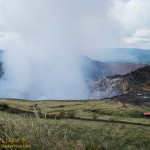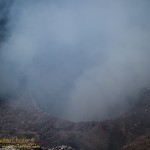I do like exploring volcanoes. As I live on an active volcano, with three other active volcanoes visible on the horizon, this sort of exploration is something I am regularly able to indulge myself with. The fifth nearby active volcano can not be seen from home, it takes a two hour drive to reach, a worthwhile trip as it is the one that is currently erupting. Since I have so many volcanoes in my life why would I want to visit another one? Because I love volcanoes!

While Masaya is not currently hosting any major activity it is home to an ephemeral lava lake and emits a steady plume of volcanic gasses. In many ways it is similar to visiting the Halemaʻumaʻu crater at Kilauea, a large pit with a plume of gasses. Like Halemaʻumaʻu, these craters are part of a larger volcanic edifice. There are three pit craters including San Fernando, Santiago, Nindiri and San Pedro that occupy the top of a complex of cones at the center of the caldera. The Masaya caldera is about seven miles wide with a large lake at the southeastern end. The last major eruption and lava flow was in 1670, with current activity confined to outgassing and the occasional ash plume.
The park features a very good museum, with displays that explain the volcano’s place in the Central American Volcanic Arc, a chain of volcanoes the stretches north to south across much of the region, from Guatemala to Panama. While flying across the country this chain of volcanoes is obvious, a line of dramatic stratovolcanoes from horizon to horizon.

There are dangers in getting this close, in 2001 a small eruption threw rocks across the parking lot and a number of tourists suffered minor injuries. Similar small ash plume eruptions continue. These eruptions apparently come with little warning, you travel here at your own risk.
Definitely worth the visit! This makes three erupting volcanoes I have visited, each quite different. Still a few things on the bucket list to see… An active lava fountain and an advancing aʻa lava flow at the top of the list. With Mauna Loa currently rumbling there is the chance that our home island may see another eruption. Who knows?

